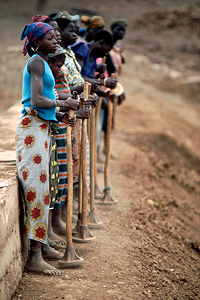Research Brief
Burkina Faso – growth without poverty reduction
Burkina Faso is a landlocked country in West Africa, poor in natural resources, and with low levels of human development. Its economy remains agricultural and focused on food crops and cotton production. Over the last twenty years it has experienced average annual growth of around 2%. However poverty rates have remained unchanged. Burkina Faso’s growth was mainly agricultural and driven by the expansion of arable land, not productivity enhancements, trapping a large segment of the population in poverty.
Burkina Faso has experienced consistent aggregate growth over the past two decades, but that growth has not been transformed into significant poverty reduction
Poverty is considerably higher in rural than urban areas
The main causes of poverty are the lack of rural productivity, unmanaged rural exodus, and a growing population size

Causes of poverty
1. Rural productivity
Output has grown the most in agriculture, at 50%; agriculture offered the highest sectoral returns in real terms during 1994-2011. Nevertheless, it is still only tantamount to 2.5% average annual real growth over this period, which is very low given the country’s level of development.
The growth in real agricultural returns per capita were driven by an expansion of the land cultivated and increases in food prices, not productivity, which remained low due to limited adoption of technology. The surface of land cultivated for food crops in 2009-10 is close to 140% the surface cultivated in 1995-96, while in the same period land used for cotton expanded to close to 300% the area in the 1990s. This underperformance of productivity growth together with very limited integration with international markets explains the high levels of food prices in Burkina Faso.
2. Urban rural migration
A rise of real GDP per capita in the agricultural sector can be in part explained by the rural exodus that took place. Although the majority of the population and 90% of the poor remain in rural areas and engaged in agricultural activities, urban population expanded four-fold in the last twenty years. This large growth was not matched by a structural evolution of the urban economy.

In urban areas however, unemployment was the rule, describing the status of between 40-50% of those surveyed. Fewer than 10% reported having a job in the formal sector, which is consistent with urban poverty growth outpacing its rural counterpart.
3. Population growth
The stagnation of agricultural growth combined with massive population growth (the population size has doubled since 1985) has caused the country to experience a steady rise in food prices, which erodes the purchasing power of the population and hence prevents significant reductions in poverty from materializing.
The drought of 1998 was particularly expensive for low-income households whose real expenditure per capita fell, whereas that of the rest of the country increased in that period. Between 1994 and 2003, real expenditure per capita of poor households grew only by 0.84% yearly, whereas that of the country as a whole grew by 2.59%. Food price inflation is so substantial that child malnutrition and mortality rates are still very high, and temporarily even on the rise. Taming these Malthusian forces will be the major challenge for Burkina Faso in the decades to come.
If poverty is to be reduced in rural areas the agricultural sector must modernise itself
Better management of urbanization and appropriate industrial policies would allow the country to develop in non-agricultural sectors and increase employment in the formal sector
Given the physical limitations to production increases through land expansion, growing population, limited educational progress, and Burkina Faso’s limited integration into international markets, poverty will remain a serious problem in the future.
 Join the network
Join the network